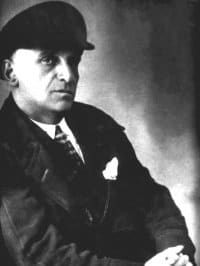Arshak Bourjalian was a well-known figure in the avant-garde of Russian and Armenian theater during the first decades of the twentieth century. He was born in Astrakhan (Russia) on January 7, 1880. His elder brother Gevorg had already made a name for himself in Russian theater and was close friends with internationally famous theater director and theoretician Konstantin Stanislavski.
After graduating from high school in Astrakhan, Bourjalian went to Moscow to continue his education. There, he became closely acquainted with the theatrical activities of his elder brother and decided to apply for the Society of Art and Letters that Stanislavski headed and which was already known in all of Russia.
After a couple of years working there, in 1898 Bourjalian left for St. Petersburg to study at the navy institute. He graduated in 1902-1903 and went to Paris. He returned to Moscow in 1908 and was admitted to the cabaret-theater “The Bat,” which had been founded by Stanislavski’s initiative on the basis of the comedies organized by the actors of his Moscow Theater of Art. The soul of “The Bat” was Mkrtich Balian (Nikita Baliyev), an Armenian actor of the Theater of Art. Bourjalian learned there to appreciate the actor’s mastery, acting technique, and the ability to control the body.
He went to Rostov-on-the-Don in 1919 on a tour with the theater group “Korshi,” but the attack of the counterrevolutionary forces during the civil war forced the group to disperse. Bourjalian stayed in the city and, with his enthusiastic participation, two Russian theaters were created in the spirit of “The Bat.” His frequent appearances in both made him well-known, and the movie studio “Renaissance” of Rostov invited him to give lectures about facial expressions. In Rostov, he established his first connection with Armenian theater through his collaboration with the theater group created by playwright Alexander Abelian.
Afterwards, Bourjalian moved to Tiflis, where his masterful command of cabaret-theater made him well-known. His stagecraft was characterized by colorful and picturesque details. He staged performances of revolutionary spirit for the Revolutionary Artistic Theater of the city. In 1922 he was invited to direct the theater group Armenian Drama and the theatrical section of the Armenian House of Art (Hayardoon). He devoted the rest of his life to Armenian theater. During three years (1922-1924), he stage dozens of plays in different theaters of Tiflis, as well as twenty-five plays with Hay Drama, the student stage of the Armenian studio, and the First Theater of Yerevan, which reflected his forward-thinking.
After working in the First Theater of Yerevan (1923-1927), Bourjalian returned to Tiflis to direct the Armenian Theater of the city until 1931. He was artistic director of the Armenian dramatic theater of Rostov-on the Don (1931) and head director of the Azerbaijani theater of Tiflis (1931-1932) until he was invited to become head director of the Spendiarian Opera and Ballet Theater of Yerevan, where he worked until 1938, making enormous improvement in the preparation of new actor and the stagecraft of operas.
After working at the Azerbaijani theater of Yerevan (1938-1941) and the Dramatic Theater of Leninakan, the current Gumri (1941-1943), poor health severed Bourjalian’s ties with theaters. He spent his last years in Tiflis, where he passed away on September 4, 1946.
